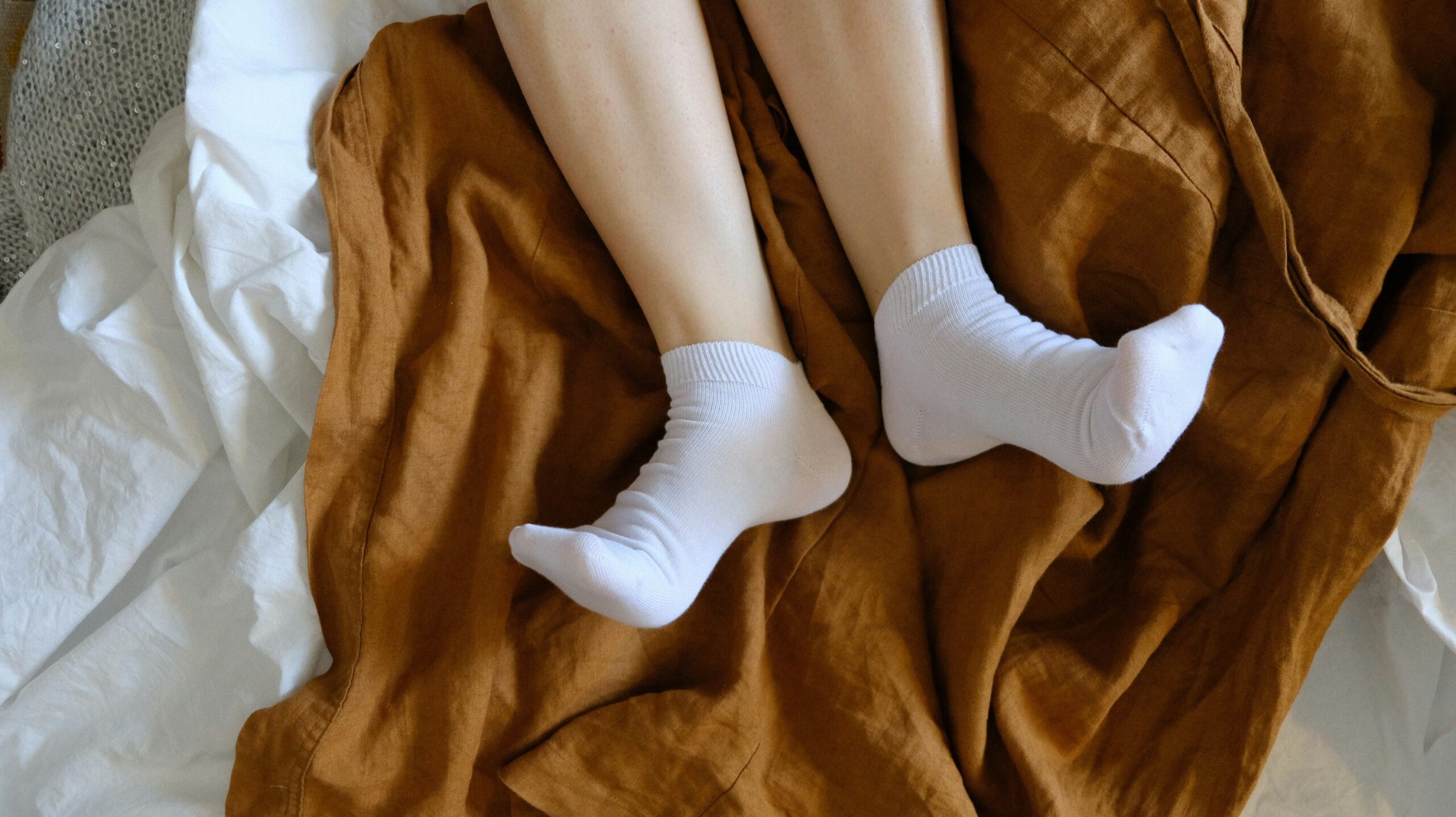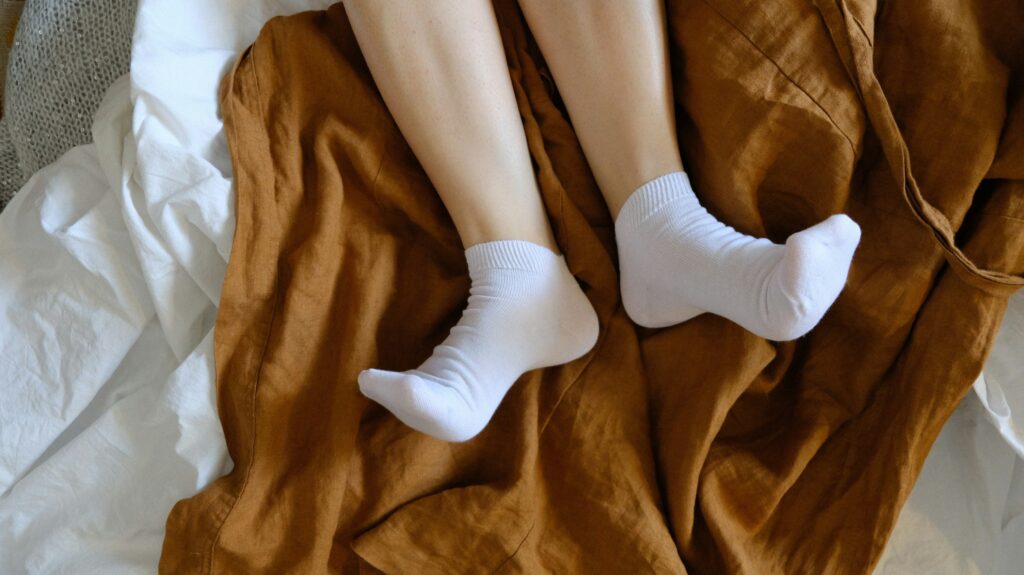
Restless Leg Syndrome in Menopause – Is It Normal?
As if we weren’t already dealing with enough, restless leg syndrome in menopause is – unfortunately – fairly common.
But why? How do our legs ache, feel heavy, and feel like they’re full of pins and needles because we’ve reached menopause?
Let’s take a look at restless leg syndrome during perimenopause and menopause – because understanding why it happens is the first step toward relief.
Last Updated:
What is restless leg syndrome?
Restless leg syndrome (RLS) is a relatively common condition which causes someone to feel like they really need to move their legs.
Usually, this happens in tandem with something called paraesthesia – which means a broader disturbance in sensation.
What does restless leg syndrome in menopause feel like?
So, what does restless leg syndrome feel like?
Realistically, menopause impacts so many different parts of the body, including the feet, arms, legs and hands.
If you’re experiencing restless leg syndrome in menopause, it may feel like:
- Tingling in the body, particularly in the legs. However, it can spread all over. This makes it tricky to sleep.
- Pins and needles. This can originate in your hands or feet suddenly, and it’s more common at night time.
- Feeling like something is crawling on you. This feels pretty gross, if we’re being honest. Some women have reported feeling like there are ants crawling on their skin. This is a challenge and a half when it comes to falling asleep.
- Numbness spreading in your hands or feet. It can feel like you’ve used numbing cream, leading to a complete loss of sensation in your hands or feet. Remember, this isn’t permanent.
- Pain in your joints. Achy muscles and joints as well as locked knees are common during menopause and perimenopause due to fluctuating hormones.
Is restless leg syndrome in menopause normal?
RLS in menopause is, in fact, pretty common. In fact, in one study that monitored 5000 perimenopausal and menopausal women found that 18.1% of 45 to 54 year old women experienced restless leg syndrome. When looking at the 55 to 64 year old group, this increased to 20.9%.
So, yes – during perimenopause and menopause, it’s considered “normal” and frequent to experience RLS.
What causes restless leg syndrome in menopause?
Unfortunately, there’s little knowledge surrounding what causes restless leg syndrome as a whole.
That said, we do know that genetics play a huge part and that, when your brain is lacking in dopamine, it’s more common.
We also know that restless leg syndrome in perimenopause and menopause is more common than pre-menopause. While we don’t have a 100% answer for why that is, there are theories.
One theory suggests that falling oestrogen levels can influence your dopamine production, as well as glutamate, which then results in restless leg syndrome.
However, it’s important to note that restless leg syndrome can also be down to underlying health conditions. You may believe RLS in perimenopause and menopause is all down to hormone changes, but it’s important to share your symptoms with a doctor.
Conditions that can cause restless leg syndrome, for example, include low iron, kidney disease, underactive thyroid and diabetes. So, if you’re experiencing restless leg syndrome, you’ll need to let your doctor know to rule out any other health conditions.

Who is likely to experience RLS?
Restless leg syndrome during menopause can be unpredictable, coming on suddenly and without explanation. However, you aren’t confined to getting RLS only in perimenopause and menopause.
You’re more likely to develop restless leg syndrome if:
- You’re a woman
- You’re 40+ years old
- You’re pregnant or you had restless leg syndrome during your pregnancy
- Restless leg syndrome runs in your family
- You experience night sweats during your menopause
- You are anaemic
- You have any of the following conditions:
- Kidney failure
- Underactive thyroid
- Rheumatoid arthritis
- Diabetes
- Fibromyalgia
What helps with RLS in menopause?
If you think you’ve been experiencing RLS during perimenopause or menopause, it’s really important to book an appointment with your GP. They will need to ensure you have no underlying medical conditions that have triggered this symptom.
After medical conditions have been ruled out, you can start experimenting with strategies to help your restless leg syndrome. Remember, everybody is different and every body is different. What works for one person may not work for another.
That said, there are things you can do at home to improve RLS:
- Stop smoking or vaping as this can trigger restless legs
- Avoid consuming caffeine (or, at the very least you should cut back) and alcohol
- Work on weight control. Menopause and perimenopause often comes with weight gain, which can trigger restless leg syndrome.
- Manage your stress levels as best as you can. Stress can cause restless leg syndrome.
- Routine, gentle exercise. Not only does this help as a weight loss strategy, but it will reduce the sensation of restless legs.
- Make sure you are following a good sleep routine and practicing healthy sleep habits, such as avoiding screens before bed. A lack of sleep can often make restless leg syndrome worse.
- Have a warm bath and soak your legs in the water.
- Use a hot water bottle or a cold compress and apply to your legs. This won’t make restless leg syndrome in menopause disappear, but it can provide temporary relief which may help you sleep.
When to see a doctor about restless leg syndrome
If you are experiencing restless leg syndrome – whether that’s during perimenopause, menopause or at any other stage of your life – you should keep your doctor in the loop.
While it may be the change to your hormones that is causing your restless leg syndrome, it may be an indication of an underlying medical condition.
As with any new symptom, it’s always safer to get everything checked out. So, the moment you notice signs of restless leg syndrome, book an appointment with your GP.
Remember, restless leg syndrome in menopause may feel like:
- A crawling sensation on your skin
- Persistent itching
- Feeling like your legs are pulling or tugging
- Your legs are throbbing or burning
- Your legs are aching for long periods of time
- You feel the need to move your legs for relief
Restless leg syndrome in menopause – in a nutshell
Restless leg syndrome in menopause can be frustrating and contribute towards sleep loss. Sleep disruption makes almost every symptom of menopause worse, including brain fog, hot flashes and night sweats, low libido, anxiety and low mood, and – of course – menopause fatigue.
However, there are home remedies for restless leg syndrome that include soaking your legs in a warm bath, using a hot water bottle, prioritising and protecting your sleep and managing your stress levels as best as you can.
While this symptom is still being explored, we do know that if you’re suffering from restless leg syndrome in menopause, you’re not alone. As with any symptom, remember to seek menopause help if you need it.
If you are experiencing restless leg syndrome, you must make sure you speak with your doctor to rule out any underlying health conditions. It’s always better to be safe than sorry, and your doctor is there to help you.
Leave a Reply
- free ebook alert -
WHAT TO EXPECT WHEN YOU’RE
going through the menopause
Demystify your understanding of what’s happening to you. Arm yourself with solid, game-changing information to support you through this challenging phase of your life.
grab your copy now →
WHAT TO EXPECT WHEN YOU’RE
going through the menopause